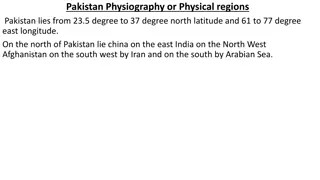Physical Geography of Pakistan: Mountains, Plains, Plateaus, and Deserts
Pakistan's diverse physical features include towering mountains like the Karakoram and Himalayas, expansive plains, elevated plateaus, and vast deserts. The country shares borders with China, India, Iran, Afghanistan, and the Arabian Sea. The Northern Mountains consist of distinct ranges like the Karakoram, Hindu Kush, and Safed Koh, each with unique characteristics. The Great Himalayas, Lesser Himalayas, and Sub-Himalayas dominate the landscape, with peaks like K-2 making their mark. Explore Pakistan's rich physical divisions and topographical wonders.
Download Presentation

Please find below an Image/Link to download the presentation.
The content on the website is provided AS IS for your information and personal use only. It may not be sold, licensed, or shared on other websites without obtaining consent from the author. Download presentation by click this link. If you encounter any issues during the download, it is possible that the publisher has removed the file from their server.
E N D
Presentation Transcript
Physical Features of Pakistan
Neighbors of Pakistan Coordinates: Latitude: 24 N - 37 N Longitude: 61 E - 75.5 E TotalArea: 796,096 sq km Altitude: Highest point: K-2 (8611m) Deepest point: Dasu patan (6500m) Lowest point: Sea level 0 (feet)
Immediate Neighbor Countries Countries Direction Length of border (Km) 592 1600 1000 850 2250 China India North East South SouthWest West Arabian Sea Iran Afghanistan
Physical Division of Pakistan Generally We can classify the Pakistan into Four Major Physical provinces which are: Mountains 2. Plains 3. Plateaus 4. Deserts 1.
Mountains There are three distinct Mountain ranges Northern Mountains Karakoram Ranges Himalaya Ranges o GreaterHimalayas o LesserHimalayas o Siwaliks North Western Mountains Hindukush Western Mountains Safed Koh Ranges Waziristan Hills Suleman and Kirthar Range o o o o o o
Northern Mountains Himalayas: Sub Himalayas Height: 600-1200 meter Lesser Himalayas Height: 1800-4600 meter Great Himalayas Height: more than 4600 meter
Northern Mountains Karakorum: Average height is about 6100 meter Goodwin Austin (K-2) 2nd highestpeak
North Western Mountains Hindu Kush Mountains: Originates from Pamir plateau. highest peaks are Noshaq (7369 m) and Tirch mir (7690 m) lies in the west of Himalaya and karakorum
Western Highlands Western highland comprises of the following three mountain ranges. The koh-e-sofaid ranges: Average height is about 3600 m Highest peak is Sikaram (4700 m) Located in East-West Direction Kurram and Kohat valley lies in this range. 1. 1. 2. 3. 4.
Western Highlands Waziristan hills: Located between Gomal and Kurram river. 2. Its Height ranges from 1500 - 3000 meter. 3. These range forms the border between Afghanistan and Pakistan 4. Famous Khyber pass lies in this Range. 1.
Western Highlands The Suleman and Kirthar Ranges: Starts from South of Gomal River Lies between the Baluchistan plateau and the Indus river. Average height is about 600 m. Takht-e-Suleman is the highest point (3487 m) In south The Suleman joins the kirthar range. And Kirthar merges into the kohistan area of Sindh. 1. 2. 3. 4. 5. 6.
The Suleman and Kirthar Ranges: Here We can see the Releif of Suleman and Kirthar range
The Indus Plains The Whole Indus plain comprises the 20% of the Pakistan. We can divide it into three parts; 1. Upper Indus Plain 2. Lower Indus Plain 3. Deltaic Plain
The Indus Plains The Upper Indus Plains: Extends from Attock to Mithan kot. Jhelum, Chenab, Ravi and Sutlej are the Eastern tributaries of river Indus. The area between the two tributaries is called Doab. All the tributaries meet at the point called Panjnad. Name of Doab Bari Doab Rachna Doab Chaj Doab Name of Rivers River Beas & River Ravi River Ravi & River Chenab River Chenab & River Jhelum River Jhelum & River Indus Sindh Sagar Doab
The Indus Plains The Lower Indus Plains: It extends from Mithan kot to Thatta. This is the old stage of river Indus. Due to the very less gradient speed of Indus is very slow.
The Indus Plains The Deltaic Plain: Total length is 1000 km While 700 Km lies in Baluchistan And about 300 km lies in Sind. Thatta and Badin districts in Sind.\ Mangrove forests are the significant feature of the Sind Deltaic plain. The coastal area lies in Baluchistan is called makran coastal plain.
Deserts of Pakistan Deserts in Pakistan Thar Thal Kharan Cholistan
Deserts of Pakistan Thar Desert: This desert lies in the South east of Pakistan. This desert is the extension of Rajasthan desert of India. The Section of this desert situated in the Bahawalpur division is called Cholistan.
Deserts of Pakistan Thal Desert: Thal desert lies between the River Indus and Jhelum. Kharan Desert: The Kharan desert located in the North west Baluchistan. The average rainfall is less than 100 mm.
The Plateaus of Pakistan Plateaus of Pakistan Baluchistan Plateau Potowar Plateau and Salt Range
The Plateaus of Pakistan The Baluchistan Plateau: Located in Southwest of Pakistan. Average height is about 300 600 meters. Very rich in mineral resources. Scanty Rain fall. Inland drainage.
The Plateaus of Pakistan The Potwar Plateau & The Salt Range: Located between River Indus & RiverJhelum Height 300 to 600 meters from sea level. Soan River is main river. It forms gullies and large alluvial plains, mainly used for agriculture. Rich in minerals like rock salt, gypsum, lime stone,coal, marble, clays, dolomite & soapstone and oil. While average height of Salt range is 750 to 900m. Sakesar Peak is the highest point in the Salt Range ata height of 1527m. 1. 2. 3. 4. 5. 6.
Thank You Source:- linkedin/slideshare































